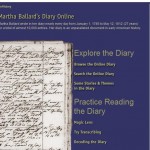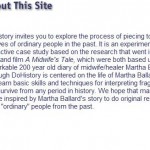If you have ever heard the phrase “Well-behaved women seldom make history” then you have heard the words of Laurel Thatcher Ulrich. Often the saying is used to encourage misbehavior from women. For Ulrich, it meant that we need to search for the silent figures that do not always make history headlines. Ulrich wrote a popular book A Midwife’s Tale. In her book she follows the diary of a midwife, Martha Ballard, in Maine. Her book is written using several primary sources. The most important primary source she used was the diary of Martha Ballard. In my final semester as an undergrad student, Ulrich spoke to a class of students about the importance of primary sources. The website DoHistory encourages the public to engage with primary sources. The website is created by Film Study Center, Harvard University and hosted by Center for History and New Media, George Mason University. Ulrich is currently a professor at Harvard.
DoHistory reaches out to several interests. They focus on seven areas that connect to the Martha Ballard’s diary. These areas are: Martha Ballard, genealogy, how to use primary sources, midwifery and herbal medicine, teaching with this website, diaries, and films about the past. The project’s objective is stated in the “about the site” http://dohistory.org/about/site.html.
The website is intended to be an example of how to piece history together. They use Martha Ballard as case study. The website gives access to Ballard’s diary in two ways. It show the diary transcribed and in its original form. This section of the website http://dohistory.org/diary/index.html allows the user to “Explore the Diary” or “Practice reading the Diary.” The main page of the website gives full access to the Ulrich’s book and the PBS film made after Ulrich’s book. The “Archive of Primary Documents” gives examples of the ample primary sources that are available for study. The “Doing History” link shows a model of how to compare and contrast primary documents. The “On Your Own” link http://dohistory.org/on_your_own/index.html
gives helpful resources to move forward with your own research projects. The “On Your Own” link illustrates the websites purpose, to promote the user to research other primary documents in history, particularly, to do “research on other “ordinary” people from the past.”
The project is a small cross section of history. The project size is ideal. It is not overwhelming for a new researcher to grasp and gives a variety of ideas on how to work with history. I would not add more to the case study because the expansion could lose the purpose of the project. In all aspects of this website it links to the use of primary documents. If the website were to add, for example, how to use secondary sources it would lose the emphasis on primary sources. The project could be replicated for a secondary source use. A website could be created that mirrored the use of secondary sources with a case study. Creating second website would allow for the purpose of both websites having independent thesis statements.
The participation on the website ranges from general interest to being taught at college level courses. This is shown in the seven categories. It gives teaching helps and reaches to specific interests, such as, midwifery. The intended use of the public for this project is specific to the seven categories listed for interests. The website does try to develop several angles in which a person would be able to find interest in the topic. For example, if you are not interested in midwifery, perhaps your interest is genealogy. The same case study can be used to educate the user on how to piece history together. The set up of the website could be used for a Boise public history project. A case study that could be used for Idaho is the Idaho’s “Trial of the Century,” in which, Clarence Darrow came to Idaho as defense attorney for the trail for the assassination of former governor Steuneburg. The interest of the public would be exact from the do history website, such as, use of primary documents, films about the past, teaching with this website, and Clarence Darrow. Other connection would be trials for assassinations, law, and early Idaho history. Unlike websites that just provide the information about the topic, DoHistory encourages critical thinking about the topic. Doing history of for the Idaho case could have the user demine their verdict to the case given primary documents available via the website.
The website is a creative tool that can be used in a classroom level. With Idaho’s new focus on “technology in the classroom.” Websites like this are helpful to encourage students to find the answer rather than being given the answer, memorize it, and write it down on a test. Adding blogs to the website for the public and student use could add an additional interactive level the website.



I love this site! Like the public history site I found, it really puts a big emphasis on primary sources, which I really like. It stays really focused on the subject at hand and doesn’t get too lost in other topics like some other history sites do. This is a great source too in that it addresses a lot of subjects that were taboo (premarital pregnancies, for one). I loved the “magic lens” feature too! I’ve done archival research before and one of the hardest parts is deciphering the writing- having a tool that does it for you is fantastic! I think your “Trial of the Century” as a case study is a great idea- it would work really well in this format and it’s something people would really dig into on a lot of different levels.
I read Laurel Thatcher Ulrich’s book which she titled Well-behaved Women Seldom Make History. I was fascinated to read in her introduction about her approach to doing history and the importance she places on reading diaries. Thanks for the explanation of the DoHistory website. It’s definitely a site I will look up. I also want to read A Midwife’s Tale.